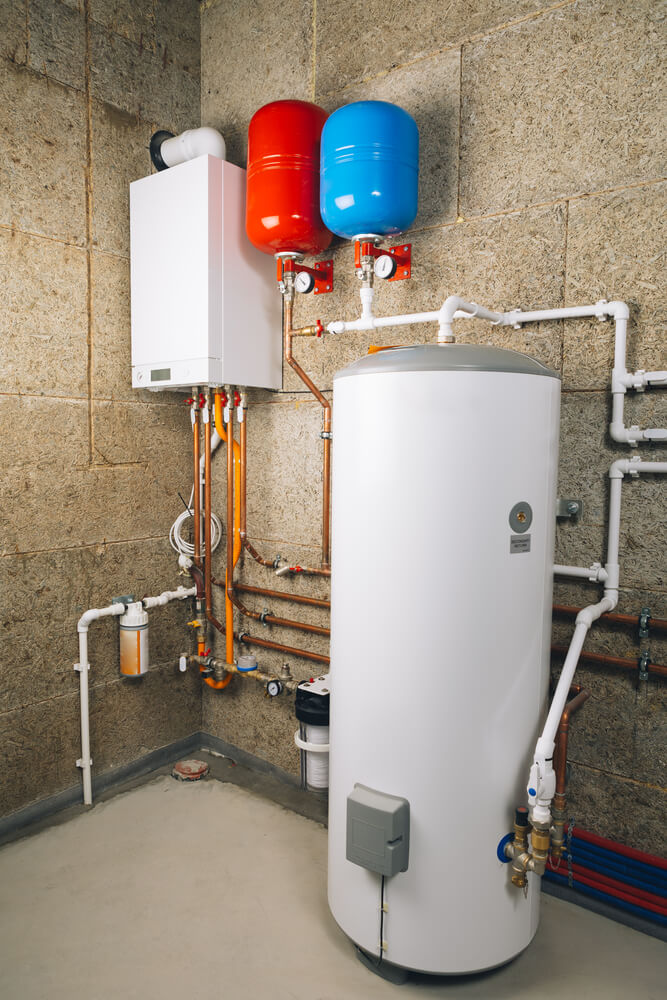
Increasing a water heater’s operational efficiency and lifespan can be accomplished through several easy and affordable methods. Specific tasks, like adjusting the temperature and adding insulation, only need to be completed once. Meanwhile, other tasks, like checking the anode rod and flushing the tank, should be done annually.
How long is a water heater’s lifespan?
Water heaters are typically low-maintenance appliances that can operate without issue for a decade or more, leading to neglect. However, dedicating a few minutes to annual water heater maintenance can increase the tank’s lifespan and ensure the heater operates efficiently and safely. If issues arise, there are some water heater repair tips available to assist in maintaining functionality.
Steps for Water Heater Maintenance
Test the TPR Valve
To begin the process, turn off the cold-water supply valve and the power supply. Next, position a bucket beneath the pipe linked to the temperature-pressure-release (TPR) valve on the tank’s top or side, which opens when the pressure in the tank becomes too high. Lift the valve’s tab to release a small amount of water, then release it. If water continues to flow, partially drain the tank, use a pipe wrench to remove the old valve, and install a new one.
Replace the Valve
If lifting the lever doesn’t release water, replacing the valve is necessary. The process is straightforward: turn off the water supply, drain the tank, remove the discharge pipe, and remove the old valve. Wrap the new valve’s threads with sealant tape before screwing it in. If your valve hasn’t been tested before and is several years old, it may leak once tested. In this case, replace the valve.
Check the Anode Rod
Attach a hose to the tank’s drain cock and release a few gallons of water. Next, utilize a 1 1/16-inch socket to unscrew the rod from the heater’s hex head on top (or beneath its top plate). If the rod’s thickness is less than 1/2 inch or it is coated with calcium, purchase a replacement, wrap its threads with Teflon tape, reinsert it into the tank, and tighten it firmly. If headroom above the tank is limited, use a segmented rod.
Drain the Tank
Empty the remaining water from the tank into the bucket, then stir up the sediment on the tank’s bottom by briefly opening the cold-water supply valve. Drain and repeat this process until clean water flows through the hose. Once this is achieved, close the drain cock, refill the tank, and turn its power supply back on.
Lower the Temperature
Remove the cover of the temperature dial on the side of the tank to adjust the dial to 120 degrees. Lowering the temperature by 10 degrees can save up to 5 per cent on energy costs. If you plan to be away from home for more than three days, turn off the water heater or set the thermostat to its lowest setting.
Insulate the Pipes
Purchase self-sticking foam pipe insulation 3/8 inch thick and matches the pipes’ diameter. Slide the foam over the water pipes as far as possible. Insulating the cold-water pipe will prevent condensation during the summer. Peel off the tape and firmly press the insulation together. Cover the pipe within 6 inches of the flue with 1-inch-thick unfaced fibreglass pipe wrap.
Insulate the Heater
Using an insulating blanket, such as R-4.5 foil-covered bubble wrap, cut it to fit around the pipes, the TPR valve, and the temperature control that protrudes from the tank. Next, wrap the sides of the tank and seal any cuts with foil tape. For electric heaters, cap them with an oversize circle of insulation and securely tape their edges to the side of the tank.
Conclusion
Regular water heater maintenance offers numerous advantages. For example, adding insulation can reduce heat loss by up to 45 per cent, saving up to 9 per cent on water heating expenses. In addition, flushing the tank to remove sediment improves longevity and efficiency.
Furthermore, ensuring a functioning anode rod is present in the tank can help prevent internal rusting, and replacing it is much more cost-effective than replacing the entire heater. By following these water heater maintenance tips, you can reduce the cost of your hot water.
FAQs
Does a water softener reduce the need for water heater maintenance?
Yes, it does. Hard water contains various metals, which can lead to sediment build-up in your water heater. A water softener can help reduce the number of minerals in the water, thus preventing sediment build-up. However, this is a temporary solution, as mineral build-up can still occur over time. Therefore, it is recommended to flush your water heater yearly to keep it in great shape, even if you have a water softener installed.
How can you tell if your water heater needs repair?
Several signs indicate your water heater may need repair, including:
- Strange smell or taste in the water
- Lower than usual water pressure
- Inadequate heating of water
- Leaking water heater
- The water heater is nearing the end of its lifespan
- Brownish or reddish tinge in the water
If you notice any of these signs, it is recommended to contact Rehan Services water heater specialists in Dubai for assistance in determining the best course of action for your water heater.
